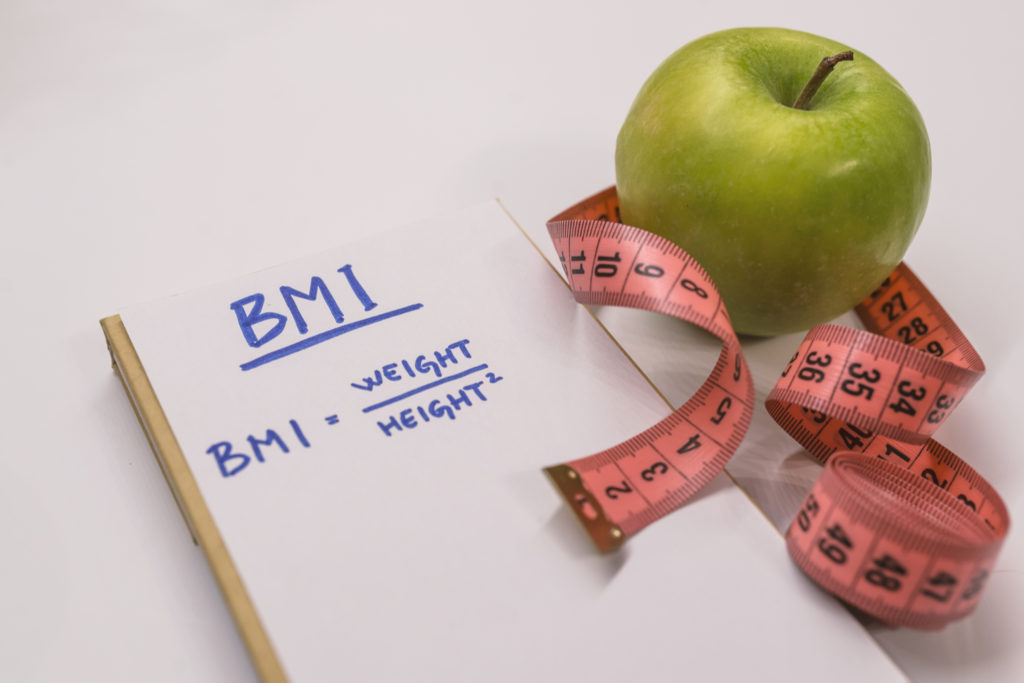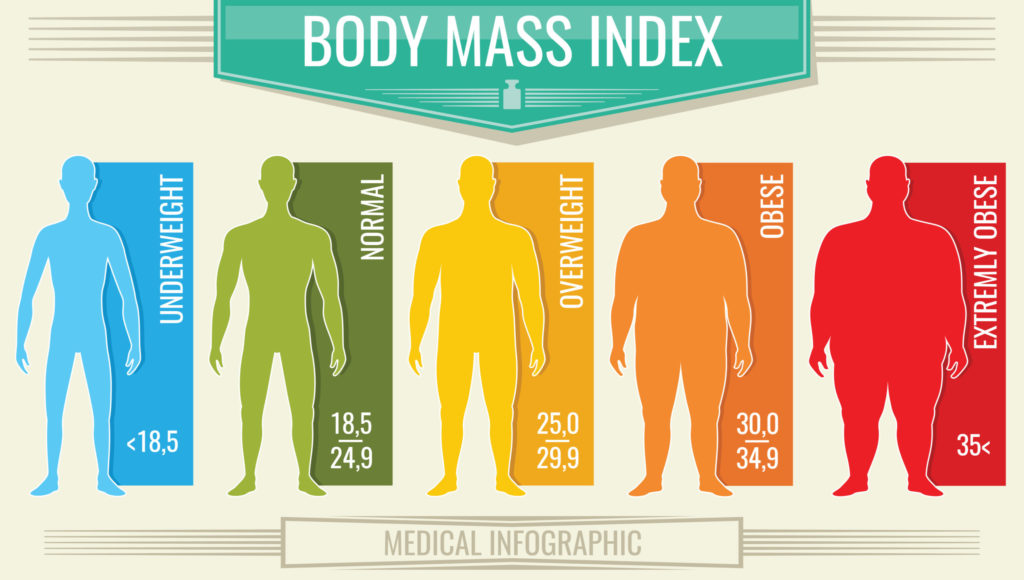SUMMARY
Your BMI can reveal a lot about your wellness. This measurement is often used to screen for weight categories that are more likely to have health problems.
Fresh N’ Lean is the nation’s largest organic meal delivery service. Our tasty, chef-prepared cuisine is always fresh and never frozen, and we offer five convenient meal plans: Protein+, Keto, Paleo, Standard Vegan and Low-Carb Vegan. Choose Fresh N’ Lean for affordable nutrition, delivered to your doorstep.
If you’re leading a busy life, it can be difficult to find the time to pay proper attention to things like calories and exercise.
Then, before you know it, you’ve gained a few extra pounds that increase body fat.
It’s a common problem. The Centers for Disease Control and Prevention (CDC) reports that a whopping 73.6 percent of adults aged 20 and over are either overweight or obese.
Does your current weight fall within a healthy range? Weight is associated with height. To understand if your weight is healthy, you’ll need to know where you stand relative to other people who are the same height as you.
That’s where BMI can shed some light. BMI is a measurement that can be used to determine whether you fall into a weight category that’s likely to develop health problems.
Your BMI can have implications for your health and well-being, so it’s worth knowing about.
In this article, we will:
- Define BMI
- Explain how BMI is calculated
- List the benefits of knowing your BMI
- Explain BMI ranges and let you know what qualifies as a healthy BMI
- Discuss the link between BMI and body fat
- Provide tips on how to lower your BMI
BMI basics

If your weight exceeds what’s considered healthy for someone of your height, you may be categorized as being overweight or obese.
BMI stands for body mass index. It’s used to estimate whether a person’s weight falls within healthy levels. BMI is used as a screening tool to determine whether someone is overweight or suffers from obesity.
You can use your BMI to get a sense of how much body fat you’re carrying. BMI doesn’t measure body fat directly, but research shows that it correlates with more direct measures of body fatness. These include bioelectrical impedance, skinfold thickness measurements and underwater weighing.
There’s one caveat to keep in mind: BMI isn’t a perfect measure of obesity. Some athletes may have a high body weight due to having more lean muscle mass than the average person. This causes certain athletes to have a high BMI even though they aren’t obese. In cases like this, BMI is usually used with a body composition assessment to determine whether a person’s weight is healthy.
How is BMI calculated?

To figure out your BMI, you first need to figure out how tall you are and how much you weigh. You can use a tape measure to arrive at your height and a scale to determine your weight.
According to the CDC, BMI is calculated by dividing a person’s weight in kilograms by the square of height in meters. It can also be calculated by dividing your weight in pounds by your height in inches squared, and multiplying this number by a conversion factor of 703.
Interested in skipping the tediousness associated with a manual BMI calculation? The easiest way to determine your BMI is to plug your height and weight into an online BMI calculator.
Benefits of knowing your BMI

Knowing your BMI provides the following benefits:
1. May help you prevent health problems associated with being overweight or obese
If you’re overweight or obese, it puts you at higher risk for a host of deadly diseases. According to the CDC, obese people are at increased risk for these health conditions:
- All causes of death (mortality)
- Stroke
- Coronary heart disease
- Hypertension (high blood pressure)
- Type 2 diabetes
- High LDL cholesterol
- Gallbladder disease
- Sleep apnea and breathing problems
- A wide range of cancers, including breast cancer, endometrial cancer, liver cancer, kidney cancer, gastric cardia cancer, multiple myeloma, colorectal cancer, pancreatic cancer, thyroid cancer and ovarian cancer
- Mental disorders such as clinical depression and anxiety
- Osteoarthritis
- Body pain and difficulty with physical functioning
The first step in dealing with a weight problem is identifying it. If your BMI indicates that you’re overweight or obese, it can give you the awareness you need to address the issue. You can then make lifestyle changes that can help you reach a healthy weight. This will lower your risk of developing diseases such as the ones mentioned above.
2. May help you prevent health problems associated with being underweight
Most of us associate weight-related health problems with obesity. But being severely underweight can also have a negative impact on your health.
If you’re underweight, you may be at risk for these health problems:
- Osteoporosis
- Anemia
- Malnutrition
- Slower-than-normal illness recovery
- Irregular heart rhythms
- Heart attack
- Infertility and lack of periods
- Slow wound healing
Figuring out where you fall on the BMI chart can help you determine whether you have a problem.
3. Helps you set meaningful health goals
If you’re on a health journey, it’s helpful to set goals. For example, you may want to reduce your waist circumference or increase your level of daily physical activity.
Your BMI number provides another measurement you can tap as you map out your health goals.
What is a healthy BMI?

Here are the BMI ranges for adults 20 and older:
- If your BMI is below 18.5, you may be viewed as being underweight.
- A BMI of 18.5 to 24.9 is seen as being in a normal or healthy weight range. This weight range is associated with living the longest and having the lowest incidence of serious disease.
- With a BMI of 25 to 25.9, you may be overweight.
- A BMI of 30 and above indicates that you may be obese.
We’ve mentioned that having a high BMI isn’t always an indicator of obesity.
Some athletes have a high BMI. Though they weigh more than the typical person of their height, their weight comes largely from muscle, not fat. This makes them very different from a person who is considered obese.
In the same way, having a lower-than-normal BMI doesn’t always indicate a health issue such as malnourishment.
Some people naturally have a hard time gaining weight. If you eat a healthy diet and your BMI has been slightly below the normal range for most or all of your life, you likely have nothing to worry about.
However, if you’ve lost weight without intending to over the past few months, a lower-than-normal BMI may indicate that there’s a problem. This type of weight loss may be linked to an overactive thyroid gland, as well as conditions such as Crohn’s disease and inflammatory bowel disease.
BMI and body fat

We’ve mentioned that BMI often correlates with a person’s level of body fat. A high BMI often means that a person is carrying a lot of fat.
Still, as we’ve discussed, BMI doesn’t always give you a complete and accurate picture of where a person stands when it comes to fat versus muscle. A very muscular individual such as a bodybuilder may have a high BMI and very little body fat.
With all this in mind, it’s easy to see how BMI can mean different things for different people. Even if two individuals have the same BMI, they may be very different in terms of how much body fat they have.
Generally speaking, at the same BMI, the following facts hold true, according to the CDC:
- Women usually have more body fat than men
- Black people tend to have less body fat than Caucasians
- Asians tend to have more body fat than Caucasians
- Older people tend to have more body fat than those who are younger
- Athletes tend to have less body fat than non-athletes
How to lower your BMI

There are clear health benefits associated with maintaining a healthy BMI. Here are some tips that can help you lower your BMI to a healthy range:
1. Reduce your caloric intake
If you want to reduce your BMI, you’ll need to burn more calories than you consume. One way to achieve this is to cut back on your daily calorie intake.
As you do this, it’s important to make sure you’re getting adequate nutrition. Replace the empty calories found in foods such as soda and cookies with nutritionally dense whole foods that provide lots of nourishment.
2. Swap processed foods for healthy whole foods
To keep your diet healthy, reduce or eliminate processed foods and processed fruit juices. These foods are typically high in calories and low in nutritional value. Many of them are also high in sugar. Excessive sugar intake can place you at higher risk for conditions such as inflammation and obesity. It can also make it much harder for you to lose weight.
Replace these foods with healthy whole foods such as fruits, nuts and vegetables. These foods are usually rich in fiber; fiber can keep you feeling full for longer periods of time, making you less likely to overeat. Whole plant foods are also nutritional powerhouses, providing you with the vitamins and minerals you need to achieve excellent health.
3. Keep track of your weight

If you want to reduce your BMI, it’s important to track your progress. You can accomplish this by weighing yourself at least once every couple of weeks.
This kind of check-in can be encouraging, since it helps you know when you’re making good progress. And if your weigh-in reveals that you’re not making the kind of progress you’d like, you can use this information to retool and revamp your weight-loss strategy accordingly.
4. Use a food journal
There are many foods that contain more calories than you’d likely imagine. That’s why a food journal is an important part of your health journey. This journal is used to log the foods you consume, as well as their calorie count. It can provide you with the information and insight you need to develop a winning plan for lowering your BMI and improving your health.
5. Increase your level of physical activity
As mentioned, you need to burn more calories than you consume to lose weight. To make sure your calorie expenditure exceeds calorie intake, you can ramp up your level of physical activity.
The most obvious way to do this is to get more exercise. For example, you can start taking daily walks or begin working out at the gym.
But there are others ways of bumping your levels of physical activity to burn calories. For example, you can choose to take the stairs instead of the elevator. And you can choose to park a couple blocks away from your destination so you’ll have the chance to experience a brisk walk.
6. Invest in a fitness tracker

If you want to improve your BMI level, it’s helpful to know what your physical activity level is like. There’s one tool that provides vital support in this area: a fitness tracker. This tool makes it easy for you to record and track your physical movements. A fitness tracker will also give you a sense of how many calories you’ve burned each day.
Fitness trackers are available that you can wear on your wrist. These trackers are also offered as apps that you can install on your smartphone.
7. Set realistic goals
It’s important to set realistic goals on your health journey. If your goals are too ambitious, you may wind up feeling disappointed when you fail to meet them. This could lead to a sense of frustration that causes you to abandon your healthy strategy and return to your old ways.
Keep in mind that even small progress matters. For example, if you have a BMI over 30, it may be several months or years before you’re able to lower it to a healthy range. But each incremental improvement you make can bring meaningful health benefits.
8. Sign up with a healthy meal delivery service

One of the easiest ways to lower your BMI involves subscribing to a healthy meal delivery service. These services deliver nutritious meals to your door. Each meal is portioned in a healthy way to prevent overeating. Also, these meals are clearly labeled with a calorie count and nutritional data, so you can easily keep track of the foods you consume.
Since it reduces or eliminates the need for cooking and grocery shopping, a meal delivery service provides another key benefit: It can help free up your schedule so you have more time to do the things you love.
Next steps
Take stock of where you currently stand by measuring your BMI. If it isn’t where you’d like it to be, design a plan to change your diet and improve your health.
Support your health journey by subscribing to Fresh N’ Lean. We deliver organic, chef-prepared foods straight to your door. Choose from our five meal plans, which range from keto to vegan.




